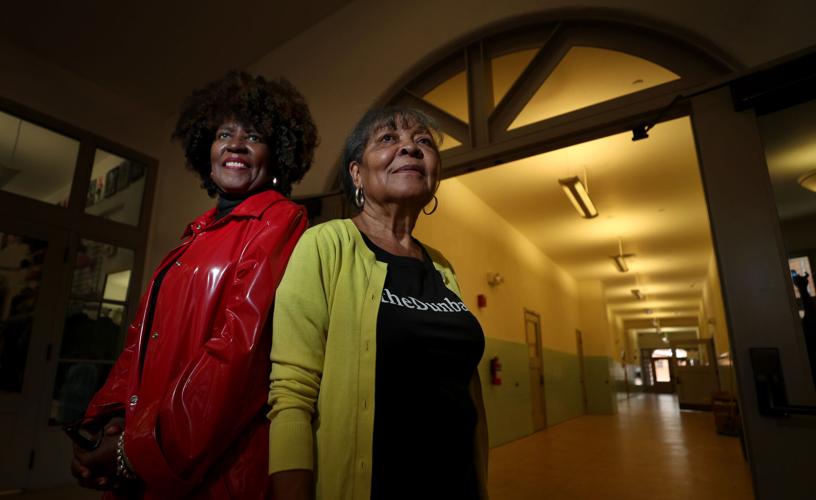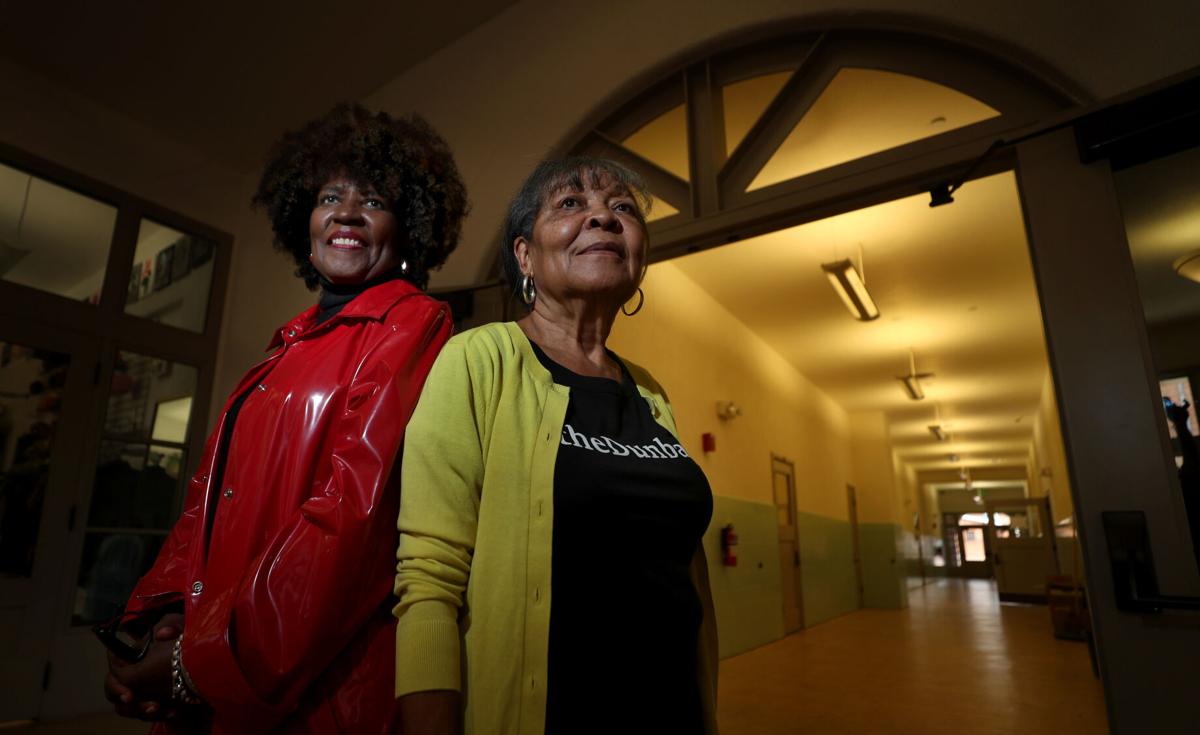At age 84, Barbara Lewis clearly remembers Dunbar School — a once segregated school for Tucson’s Black children in grades first to eighth from 1918 to 1951.
She clearly remembers going to the school at 325 W. Second St. and not having a library, auditorium, cafeteria or gymnasium. “Our auditorium was a large hallway. Our cafeteria was three-burners in an area downstairs,” said Lewis.
In 1951, under a change in Arizona law, the forerunner to Tucson Unified School District no longer mandated Black children to attend segregated schools. John Spring then became a school for Black, Mexican-American and Asian students until it was closed in 1978 after TUSD was court-ordered to desegregate its schools. It was one of three schools the district closed.
Barbara Lewis remembers singer Marian Anderson performing at the school, and a visit from poet, novelist and playwright Langston Hughes.
Today, Lewis is among board members of the nonprofit Dunbar Coalition that has worked to turn the Dunbar Pavilion, which encompasses the old historic Dunbar School and what became John Spring Junior High School into an educational, cultural, social and business center embracing and celebrating African descent. There also are plans for an African-American museum. Presently it houses office spaces, areas for community meetings and activities, and the Tucson Idea School, an independent, nonprofit K-8 school.
Lewis and fellow board member Chyrl Hill Lander and coalition chairman Sam Brown are among those rejoicing with the news that the nonprofit Dunbar Coalition was awarded over $1.1 million in federal money to continue needed renovations on the three-acre property that houses 51,758 square feet of repurposed buildings that are on the National Register of Historic Places.
U.S. Reps. Raúl Grijalva and Ann Kirkpatrick requested the funds, and the Appropriations Committee granted the award, said Grijalva. He said because Dunbar “was built on a philosophy of divisiveness and ignorance, we seek to reverse the effect of segregation by keeping the building open to all and creating a hub to learn about Black history and culture in Tucson and Southern Arizona.”
“The key to history is the truth,” said Grijalva. “Trying to rewrite, erase or ignore history is a mistake. Knowing the true history of our communities and the nation is a positive. This is part of this nation’s history that should not be forgotten. We condemn the act of segregation and the truth needs to be told and we learn much more from it,” he said.

A former science classroom needs renovation in the basement of the old Dunbar School.
Lewis said she remembers when the coalition purchased the old Dunbar building in 1995 for $25 from TUSD when the district was discussing demolishing it. “Everything was so dilapidated. The ceiling was coming down, there were broken windows and animals were living inside the building,” recalled Lewis. “We wanted the property for the love of the school itself. We knew it was a lot of work, and we are more than halfway done with renovations now. I think it has been wonderful to watch the progress.”
Much of the major work has been completed, said Lewis, including the electrical wiring, plumbing, roofing and much of the heating and cooling. “I am hoping it is all completed in my lifetime. The thought of that keeps me waking up every morning and going,” she said, reminiscing to the days Principal Morgan Maxwell Sr. invited Marian Anderson, an American contralto who performed opera to spirituals, to perform at the school. It was 1942 and she was in Tucson to perform at the University of Arizona and Anderson took time to sing to Dunbar students and eat lunch with them.
Lewis also remembers Langston Hughes, a poet, novelist and fiction writer, who came to talk to students. “He was the reason we got swamp coolers in our old school,” said Lewis. “It was hot. After he spoke to us, he made a fuss and went to the superintendent and had a fit, and we got swamp coolers,” she said. “There also were Black baseball players that came to Tucson for spring training, and they stayed in the homes of people. They came and spoke to us, too,” she said. “The good things for us individually, outweighed the bad things at Dunbar,” Lewis said.
Lander joined the coalition board after the death of her husband, Cressworth Lander, a Dunbar alum and retired top administrator in housing and economic development programs for the city. He died in 2015. “Cress was very involved in this project, serving as chair of the coalition for more than a decade, and I want to do my part to make sure the renovations are completed. Dunbar is a meaningful legacy to the history of Tucson. Because of the country’s ‘separate but equal’ mandate, it was the only school Black children living in Tucson could attend, no matter where they lived in the city. It was the only public school where Black educators could teach,” said Lander.

Black children in grades one through nine were segregated at Dunbar School from 1913-51.
“I feel great about this latest round of funding and the renovations it will support,” Lander said. “This is a great infusion of cash because since COVID everything shut down. This infusion of money will help us get work going again. The coalition has remained faithful to a master plan that specifies historically appropriate renovations to bring the facility back to its condition in the 1940s,” explained Lander.
About $6 million has been used on renovations at the pavilion since 1995 up to last year, she said. The funding has come from federal allocations, city and county community development block grants, foundations, private donations and fundraising. “We are grateful for the financial support from Dunbar alumni, family, friends, businesses, houses of worship, national and local organizations and Tucson’s elected officials,” said Lander, a former reporter and copy editor for the Arizona Daily Star and former TUSD spokeswoman.
In addition to construction of an amphitheater on the south side of the building, the latest $1.1 million will go toward restoration of upstairs classrooms and the basement, fencing around the property, landscaping, signage and furniture. The coalition also was awarded $125,000 from Arizona State Historic Preservation Office for an African-American museum.
Chyrl Hill Lander began her work on the Dunbar Coalition after her husband, Cressworth Lander, died in 2015. Cressworth Lander attended the segregated school for Black children in Tucson and was active on the coalition to preserve the historic building. Hill Lander said she wants to make sure her husband's work is completed.
The coalition needs to write grants and fundraise another $2 million to have all the work completed, Lander said. The cost summary of work to be done was prepared by the architectural firm Poster Mirto McDonald, which has supervised all renovations, Lander said.
Coalition Chairman Sam Brown, a former TUSD legal counsel who is chief civil deputy with the Pima County Attorney’s Office, said the coalition has been working to set policy and structure to take Dunbar to the next level. “We are ready to be the best Black cultural, community and arts center in the nation. We want to create something truly unique and special. We are collaborating with the Catalina Rotary Club of Tucson to build a five-year comprehensive campaign to raise $5 million, and we expect to kickoff the campaign late this year or early next year.
“This will pay for building construction and staff because we want to expand health and wellness at the center, build a family resource center, and open it up to more community organizations and family activities. We want to bring in more businesses, and create a venue for comedy shows, concerts, plays and economic activities,” said Brown.
Tucson Mayor Regina Romero said she supports the Dunbar Pavilion as part of the city’s Arts & Culture Revitalization Initiative with the city backing investment in areas that pertain to arts, history, culture and heritage in Tucson. “I want Dunbar Pavilion to be part of our investment in our strategy moving forward,” said Romero.







